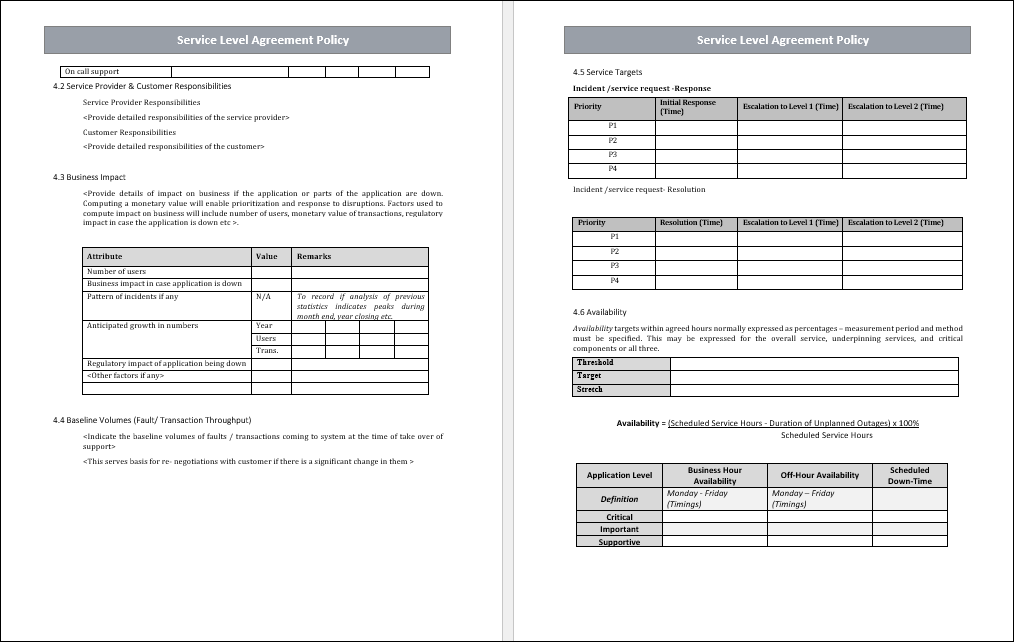Service Level Agreement Policy Template
Introduction
A Service Level Agreement (SLA) Policy Template in IT Governance is a structured document that describes the terms, conditions, and expectations that govern the delivery of IT services by a service provider to a service recipient. This complete template provides a foundation for defining the service scope, performance metrics, responsibilities, and communication protocols. It is critical for assuring consistency, standardisation, and clarity in IT service delivery, promoting effective communication, and limiting risks by creating quantifiable targets and standards.

Understanding Service Level Agreement Policy Template
The Service Level Agreement (SLA) Policy Template in IT Governance is a basic document that defines and governs the relationship between a service provider and a service recipient in the field of information technology (IT). An SLA is a commercial agreement that defines the terms, circumstances, and expectations for the supply of IT services. This policy template is a thorough guide, outlining major components such as the scope and description of services, performance metrics and standards, each party's duties, reporting systems, and Service Level Objectives. The template contributes to a shared understanding of what is anticipated in terms of service quality, availability, and responsiveness by clearly outlining the roles and responsibilities of both the service provider and the service recipient.
Implementing the Service Level Agreement Policy Template
Here is a step-by-step guide to help with the implementation process:
1. Communication and Awareness
- Inform all key stakeholders, such as IT teams, service providers, and service recipients, about the SLA Policy Template.
- Conduct training sessions or workshops to ensure that everyone understands the content of the template, their duties, and the importance of meeting SLAs.
2. Customization to Specific Needs
- Customise the SLA Policy Template to meet the specific demands and requirements of your organisation. Different services may have different SLAs, and customisation assures relevance to the organization's specific context.
3. Integration with IT Governance Frameworks
- Align the SLA Policy Template with recognised IT governance frameworks like COBIT, ITIL, and ISO/IEC 20000. Ensure conformity with overarching governance principles to improve the effectiveness of SLA implementation.
4. Establishing Metrics and Monitoring Mechanisms
- Clearly define the performance measurements and monitoring systems specified in the SLA.
- Implement a strong monitoring system to regularly track key performance indicators (KPIs). This could include the use of monitoring technologies, reporting systems, and regular performance evaluations.
5. Roles and Responsibilities
- Clearly discuss and define roles and duties for both service providers and recipients. This ensures accountability and a clear awareness of who is responsible for what components of service delivery.
6. Incident Management and Resolution
- Implement methods for incident management and resolution as outlined in the SLA Policy Template.
- Create a system for reporting incidents, tracking response timelines, and taking corrective action to solve reoccurring issues.
7. Regular Review and Updates
- Schedule periodic evaluations of the SLA to ensure that it remains current and in line with evolving business needs.
- Update the SLA as needed based on stakeholder feedback, technological advancements, and modifications in organisational goals.
8. Compliance and Legal Considerations
- Ensure that the SLA implementation meets legal and compliance standards.
- Seek legal assistance to ensure that the SLA complies with regulatory standards and protects both parties’ interests.

Best Practices Of Service Level Agreement Policy Template
1. Establish a Monitoring System
- Implement a strong monitoring system to track and measure the SLA's key performance indicators (KPIs) on a regular basis.
- Use monitoring tools, reporting systems, and performance dashboards to gain real-time information on service performance.
2. Regular Performance Reviews
- Conduct regular performance reviews, preferably on a planned basis (e.g., quarterly or annually), to determine how well the services are meeting the established SLA objectives.
- Engage stakeholders, including both service providers and recipients, in these reviews to acquire a variety of viewpoints and responses.
3. Feedback Mechanism
- Create a feedback mechanism to collect the experiences and observations of both service providers and recipients.
- Encourage open communication to discover opportunities for progress, potential challenges, and new requirements.
4. Key Performance Indicator Analysis
- Analyse data from key performance metrics to find trends, patterns, and areas for concern.
- Utilise this research to identify specific areas of the SLA that may require revision or improvement.
5. Alignment with Business Objectives
- Regularly examine the alignment of SLAs with overall company objectives and organisational priorities.
- Ensure that the SLA remains in line with changes in the business landscape, technology improvements, and strategic objectives.
Conclusion
The Service Level Agreement Policy Template is a cornerstone of IT Governance, assuring the efficient and effective delivery of information technology services inside an organisation. This thorough document allows organisations to set clear expectations, create transparency, and match IT services with overall business goals. The SLA Policy Template serves as a dynamic instrument that adapts to the evolving needs of the organization, providing a structured foundation for collaboration between service providers and recipients.


